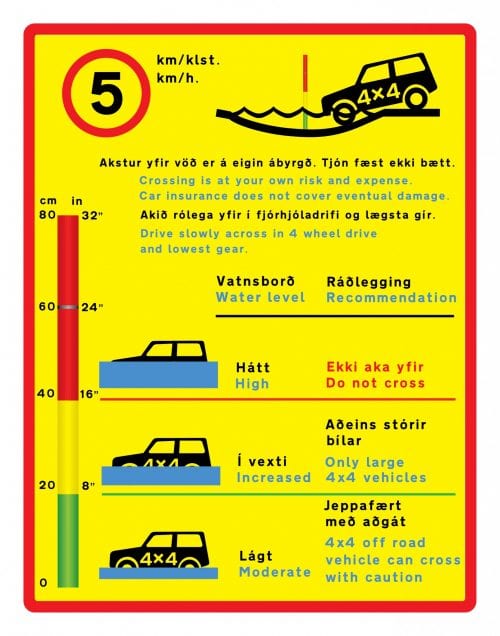One of the things you might hear about Iceland is that the island nation has the least developed road system in western Europe. Preparing to drive in Iceland means being aware of the specific hazards. It is not that every road in Iceland is bad, but that there are unique conditions that apply to the island that is not as common elsewhere.
Important safety tips
Speed limit
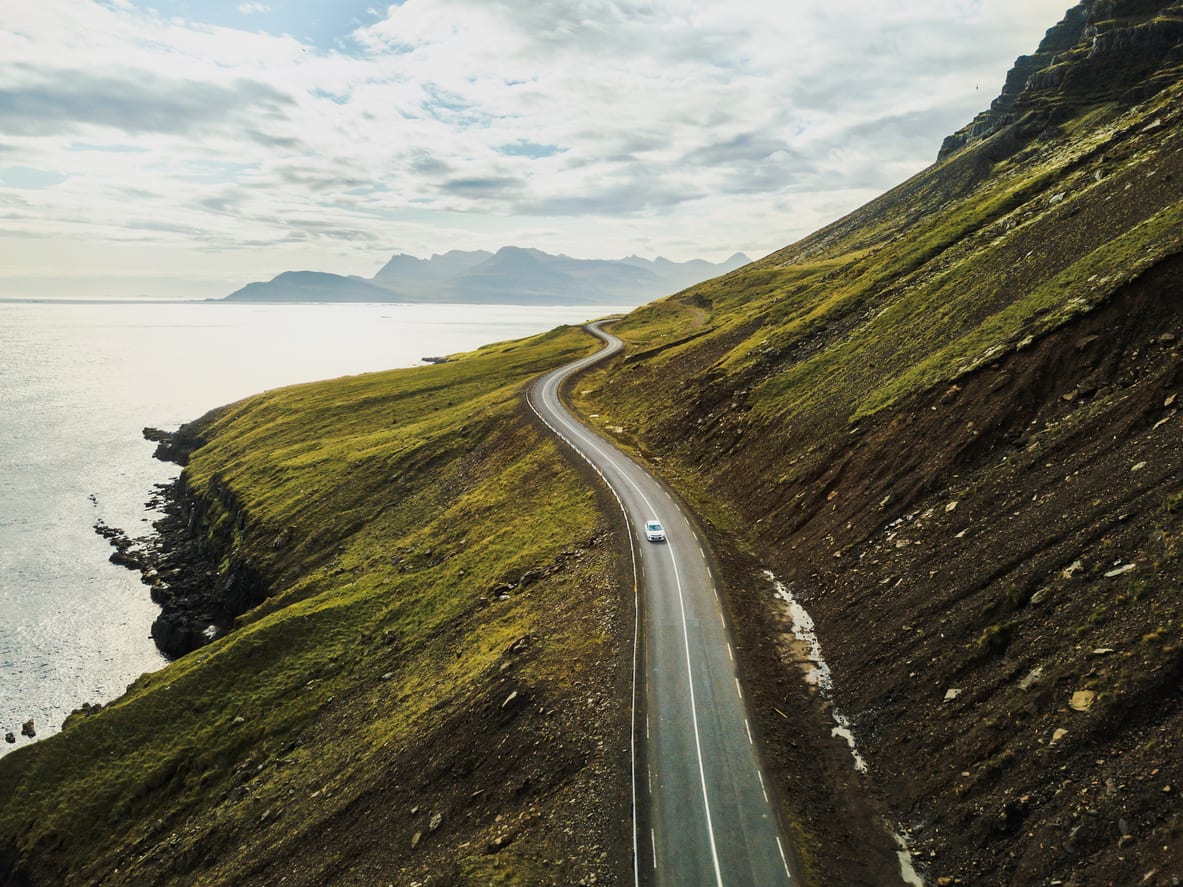
Before driving in Iceland, you should familiarize yourself with the local laws and regulations. Speed limits are in kilometers an hour, and unless marked otherwise, are 50 in urban areas, 80 on gravel roads in rural areas and 90 on paved roads. When a lower speed limit is posted, it is generally for safety reasons and should be respected.
Drinking and driving
The legal alcohol limit in Iceland is 0.05%, and it may be lowered further. The safest thing to do is not drive if you have been drinking at all.
Seat belts
Seat belts are required by law, as are car safety seats for babies and young children.
Wildlife and Livestock
Iceland has no native animals larger than the arctic fox. However, it is not uncommon for livestock, especially sheep, to wander onto roads. Drivers may be found liable if they hit and injure or kill livestock. On rural roads, you should assume that a sheep may appear at any moment. If there is a group of animals separated by the road, be aware that animals may cross to rejoin their friends without warning or looking, especially during breeding season. Sheep have a tendency to act as if they have the right of way.
Because of the lack of large wildlife, roadkill is rare in Iceland.
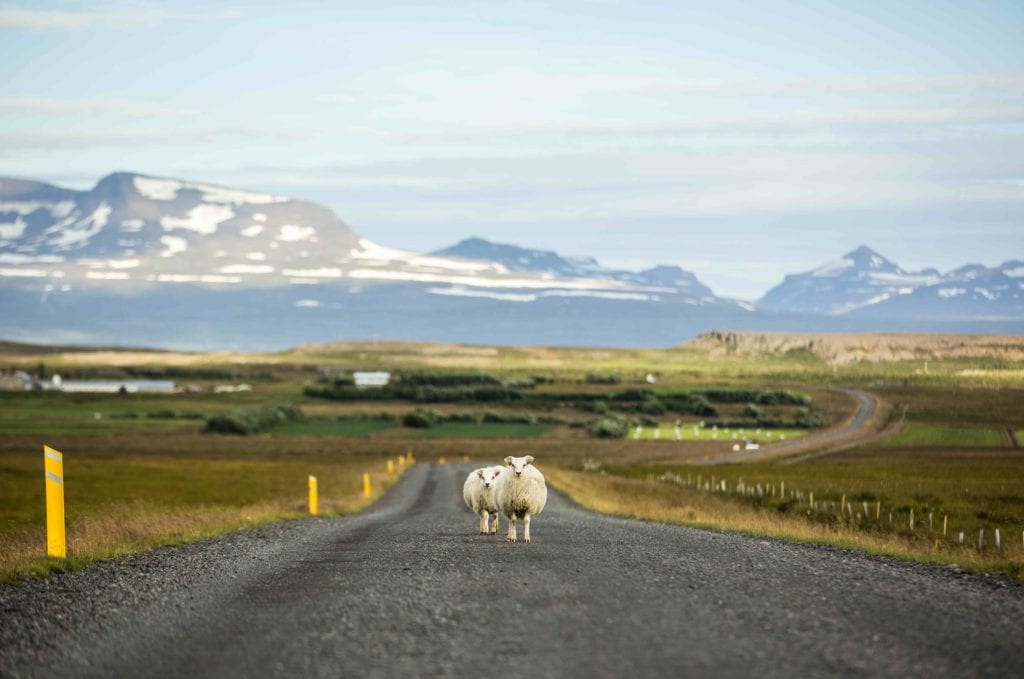
Distraction
Iceland’s gorgeous countryside is amazing to drive through, but it increases the risk of distracted driving. Make sure you keep your eyes on the road and if necessary find a safe place to pull over so you can look for a while. The risk may also be increased by the lack of traffic on some rural roads, which can also increase driver fatigue.
Unpaved Roads
The ring road that goes around Iceland, popular with tourists, is mostly paved. Mostly. The fact is that once you get out of Reykjavik, there are a lot of gravel roads. Pavement may end fairly abruptly, and a lot of accidents are caused when tourists hit the end of the paved segment without slowing down. You should slow down for the transition. If you do start to lose control, ease off the gas and steer gently in the direction the car is pulling. Watch for rough surface and keep your speed low in general. A lot of these roads are mountain roads. Always slow down when approaching an oncoming car, so as to reduce the amount of gravel being thrown up that might damage both vehicles. Allow extra time for traveling in the interior.
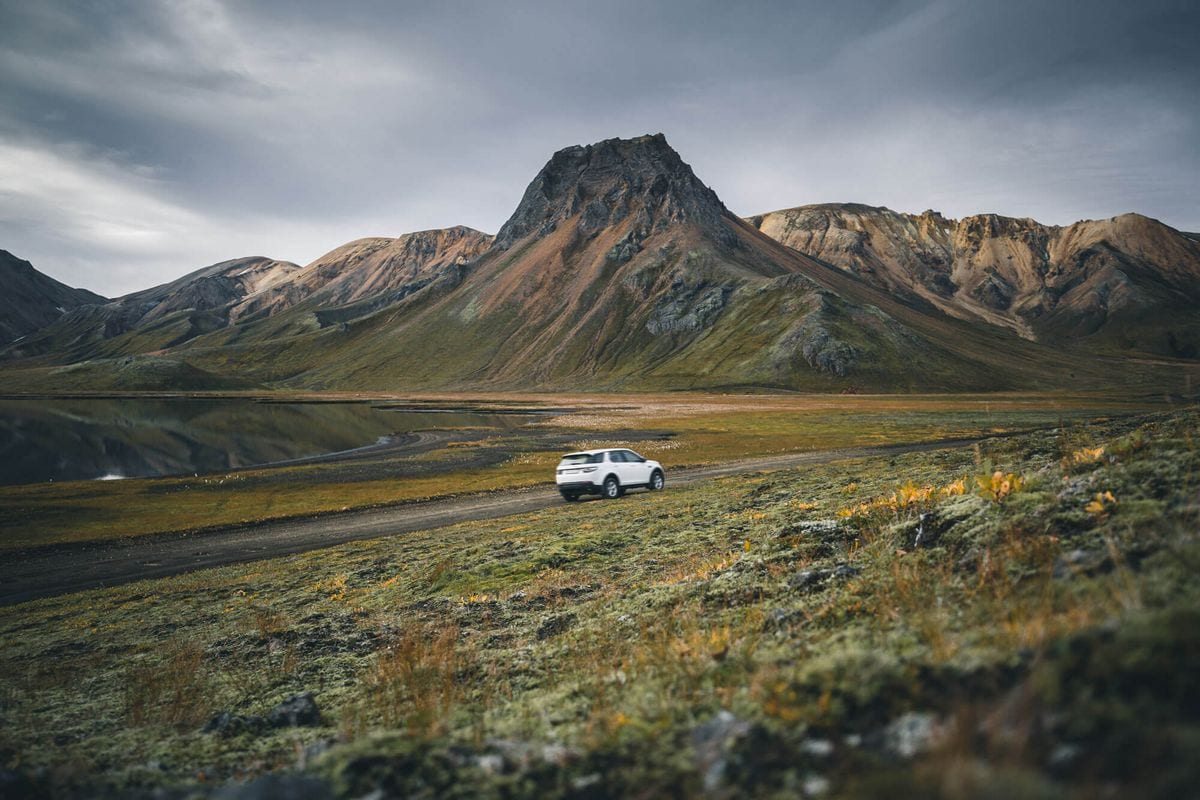
Narrow Bridges
There are many bridges in Iceland that are only wide enough for one vehicle at a time. Never play “chicken” on these bridges. Let the first vehicle to reach the bridge go across and stop with plenty of space to let them get back on the road. If they signal you to go, you can go. Slow down when approaching the bridge, as sometimes there may be a blind curve or hill on one side of it.
Stopping at the side of the road
Stopping the car on the side of the road can be dangerous and should be avoided. In case of an emergency, make sure your car is visible from all angles, turn your hazard lights on, and place the warning triangle, which is placed in the trunk of the car, five large steps behind your vehicle.
Handheld Devices
Handheld devices are illegal on the road. If you need to navigate, attach your device on the window or have your travel partner navigate if possible.
Blind Curves and Hills
Both blind curves and hills are common in Iceland, especially off the ring road. When driving in Iceland, you should pay attention to any warning signs (a lot of them are signed) and slow down accordingly. Always assume there is somebody approaching the other side of a blind hill or curve.
Weather
Icelandic weather can be very unpredictable. In the winter, overland travel on the island becomes challenging, even impossible. In spring and fall, snow squalls can still cause problems for travelers. Make sure that any mountain routes you take are open – many are open only in July and August, can only be negotiated by 4WD vehicles, and may be isolated enough that it’s advisable to a convoy. Summer is the best time to travel, but even then it can still rain occasionally. Iceland is also very windy, so be ready for windchill, and crosswinds. In spring or fall, always check the weather forecast before setting out. Black ice can also be an issue at certain times of year. If the temperature has been hovering around freezing, watch for patches of ice.
If you are not used to driving in snow, then you should take extra precautions. Drive slowly. Only major roads are generally plowed. Driving in Reykjavik is easier (but Reykjavik is also a very walkable city). Summer weather generally causes few problems.

Driving at night:
Driving at night in unpopulated areas is not recommended as weather and road conditions are often bad, accidents more likely, and assistance takes way longer to arrive.
Important road signs in Iceland
Single-lane bridges
Many bridges are too narrow to allow more than one car to pass, so slow down when approaching them. The rule is that the car closer to the bridge has the right-of-way. However, it is wise to reduce the speed significantly every time.
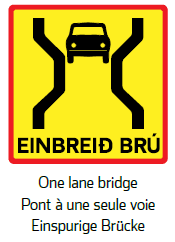
Paved road changes to gravel
It is important to reduce speed before the road changes to gravel. These types of roads are often narrow, so show caution when approaching other cars coming from the opposite direction. Flying pieces of gravel may damage the windshield if the speed is not reduced.

Blind hills
Blind hills and curves, where lanes are not separated, should be approached with caution. These are widely found throughout Iceland and test the driver’s skill.

Recommended speed
In several places, there are blue traffic signs, indicating the recommended maximum speed.

Animals on the road
In Iceland, you can expect livestock to be on or alongside the road. It’s important to reduce speed as they may well run across the road in an attempt to join other members of their group. This is common all over the country.

F – roads, highland driving & river crossing
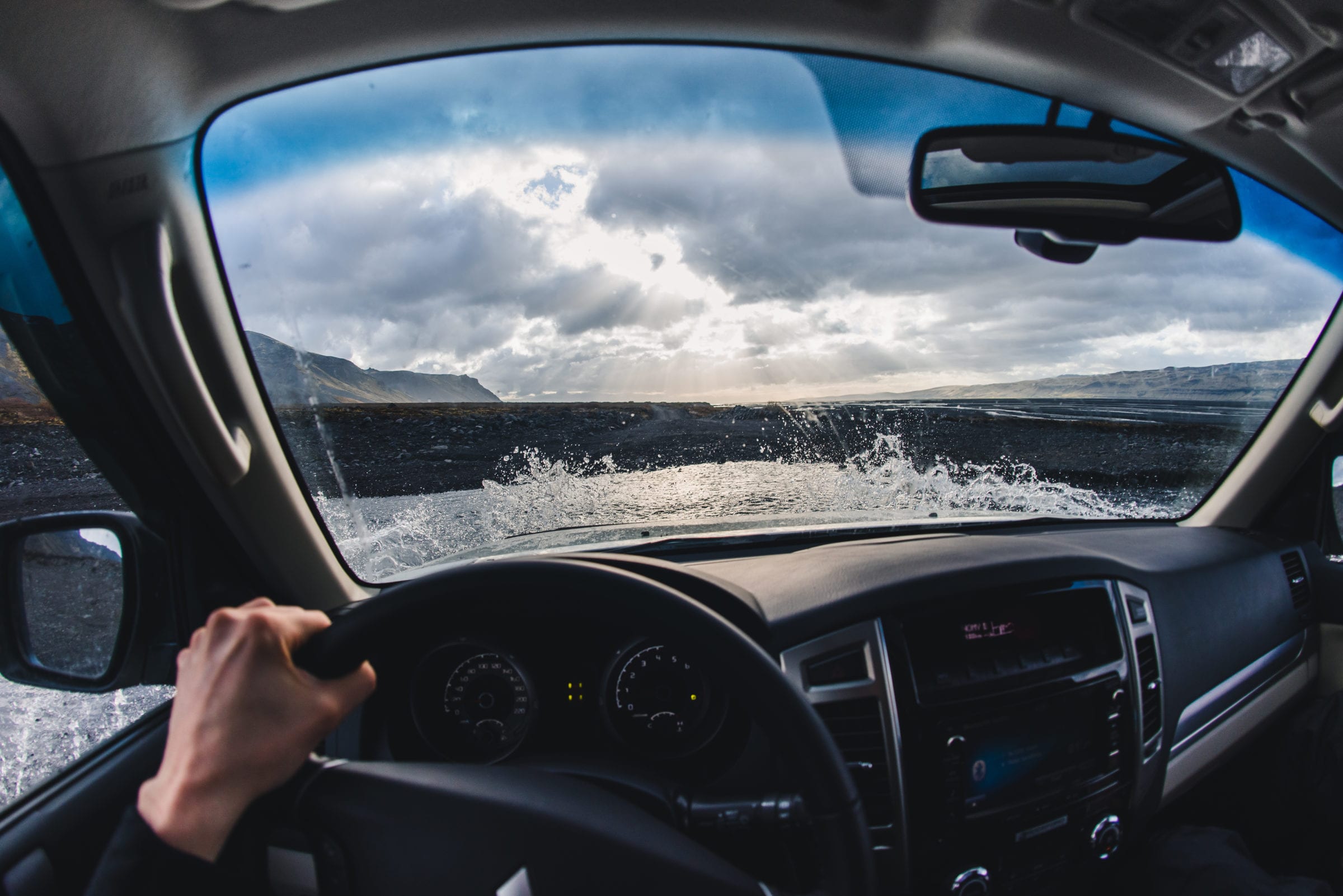
Winter
During winter, the Icelandic highlands are impassable/closed for anyone who are not in a modified vehicle (super jeep). The timing of these closures depend entirely on weather and conditions each year.
Summer
Highland driving is very popular during the summertime but requires a whole different set of skills than normal driving. Highlands roads are not open all year, so check beforehand if the planned route is available on www.road.is. Highland roads can be rough and often require you to cross unbridged rivers, so a 4×4 vehicle, with good ground clearance, is mandatory.
Important river crossing tips
Driving in the highlands will inevitably lead you to a river crossing. Keep the following things in mind:
· Non-insurable
No insurance covers any damage that can be lead to crossing rivers or any body of water. The risk is yours and damages can cost thousands of euros/dollars.
· Be 100% sure
Do not cross a river unless you are a 100% sure you will be able to get to the other side – if you’re unsure, wait for the next car to come by and decide if you can go or not.
· The current and depth changes
The current and depth of the rivers change according to glacial melt and precipitation. Keep in mind that rivers can become impassable after heavy rainfall.
· Don‘t change gears
Put your car in low-gear and cross the river slowly (5 km/h) and steady – do not switch gears while in the water.
· Drive downstream
Always try to go downstream as going against the current will increase the risk of water going into your engine.
· Don‘t let the river fool you
Do NOT enter the river if it seems calm – this is a sign of depth and is not the ideal spot to cross.
Look for signs such as the one given below and for measuring poles in the rivers. The colors indicate the depth of the rivers, but keep in mind that not all rivers have this helpful tool:
Other travel tips
Off-Roading
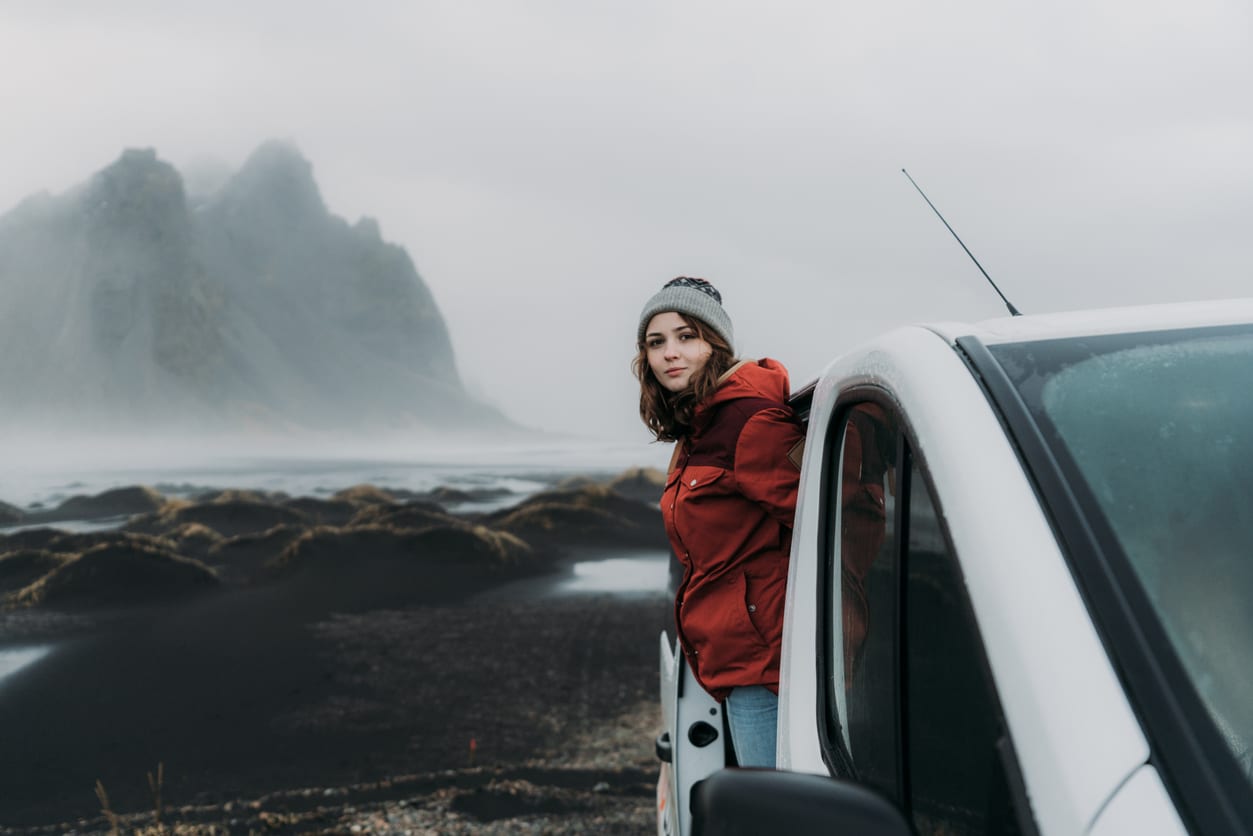
Off-roading in Iceland is always illegal, no matter where. This is because of the fragile soil and vegetation in this unique northern country. In some cases, you can actually be jailed for intentionally driving off-road. If you really want to get away from the roads, you will need to go hiking or horseback riding. The unique Icelandic horse is a particularly fun way to see remote areas. As mentioned, if you are driving into the mountains even on the roads, you will need a Jeep or similar vehicle, but that does not mean you can leave the road or marked trail.
Fuel
You do not want to run out of fuel in Iceland, so make sure you know where there are filling stations on your road. Some filling stations are open, but unmanned, 24 seven. The pumps accept credit cards (including foreign cards) and 1000 krona notes. Filling stations also tend to open late, especially around Reykjavik. So, all you need to do is plan. Always fill your tank completely, even if it was already fairly full, before going onto mountain or rural roads.
Parking
It’s relatively easy to find a parking space in Reykjavik. Also remember: Reykjavik is small. In fact, if you are only staying in Reykjavik you may not even need a car (although there are many reasons to leave). Pretty much any parking space you find is going to be a five minute or so walk to downtown. As parking spaces right in the city center are more expensive, then able bodied people should save money by parking further out. Note that if you are disabled, you should bring your disabled card or permit. Legal on-street parking is free in Iceland for disabled card holders and some car parks are also free.
Pay attention to the zone you are in. P1, the red zone, is the most expensive. If there is no P with a number on it, then parking is free unless it is indicated as being illegal. Parking is also free on Sundays. Parking meters and ticket dispensers in Reykjavik accept coins and credit cards and do not print out tickets. You have to enter your license number, so try to memorize the number on your rental to save time.
Tolls
There are currently no actual toll roads in Iceland, although this might change (but no sooner than 2020). The Vaðlaheiðargöng tunnel does have tolls, which have to be paid in advance online. Talk to your rental company and see what arrangements they have. The Hvalfjörður tunnel used to have tolls, but is now free. This situation may change, though, so you should check right before your trip to see if anything has been implemented. The growth of electric cars is causing the government to consider applying tolls on vehicles leaving and entering Reykjavik to replace lost gas tax income.
In an Emergency
Iceland generally has exceptional cell phone coverage. It’s best to get international roaming on your phone or, if cheaper, buy a “burner” phone while in Iceland. You may be able to get bars in places you would not think. The emergency number in Iceland is 112. Consider getting the 112 Iceland App from the Icelandic Association for Search and Rescue, which allows you to send your location to emergency services with the touch of a button, sometimes even if you have too poor a signal to call. Stay with your vehicle if possible. Roadside assistance can be useful, but may not help you in the interior. It’s a good idea to keep food and water in the car for emergencies. Protein bars are a very good idea as emergency rations. In winter, take a thermal blanket if possible, as temperatures can be very low even inside a non-working vehicle.
Useful resources for traveling safely in Iceland:
Weather conditions
Icelandic Meteorological Office provides detailed weather information, from wind speed to aurora forecast.
https://en.vedur.is/ | Phone number : +354 522 6000
Road conditions
The Icelandic Road and Coastal Administration provides information about the weather and the road system all over Iceland.
http://www.road.is/ | Phone number: +354 522 1000
Travel conditions and tips
Safe Travel provides a wide variety of tips for traveling in Iceland from hiking to diving but also publishes warnings about imminent dangers and alerts around the country.
Driving with Elfis
Learn More About Driving in Iceland
If you are planning on driving in Iceland, then check out some of our other useful information. Driving in Iceland can be challenging, but you should not let talk about the road system put you off, and it really is the best, sometimes the only, way to see much of the island’s spectacular countryside.
Back